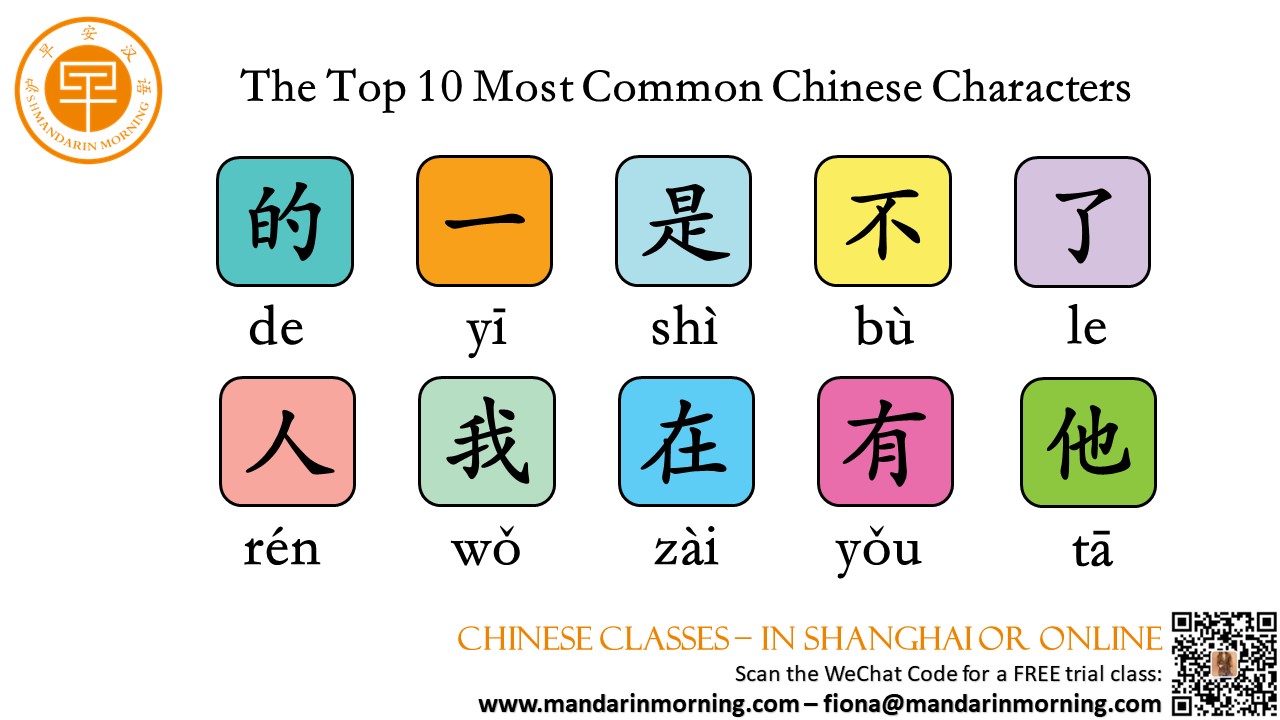| Yes, learning written Chinese is largely about your ability to retain character knowledge but you’d be surprised how often the most common Chinese characters appear in day to day life. Let’s go through the list of most popular Chinese characters one by one and give some examples of them in action. These appear in everyday Chinese everywhere you go.  #1: 的 (de – A grammatical particle) Introducing to you the most used character in the “Chinese alphabet”, 的. Funnily enough this word does not have a specific meaning or translation. “的” is one of three “de particles” in Chinese and is used to indicate possession. Let’s show you some examples: 我的手机 wǒ de shǒujī - My mobile phone 我们的老师 wǒmen de lǎoshī - Our teacher #2: 一 (yī – one or a little) The Chinese character for the number one is the most simple of them all, written with just a single stroke. The character 一 has a number of meanings making it the second most popular Chinese character. These include first, best, once, only and so forth. Here are some examples of 一 in action: 一瓶牛奶 Yī píng niúnǎi - One bottle of milk 我们看起来一样 Wǒmen kàn qǐlái yīyàng - We both look the same #3: 是 (shì – to be) 是 is generally used to link two nouns together and will be a character you see and hear every single day without fail. 我是学生 Wǒ shì xuésheng - I am a student 你是老板吗 Nǐ shì lǎobǎn ma? - Are you the boss? #4: 不 (bù – not) This is a negative and means either no or something/someone is not. It’s commonly found with the above character 是. Whereas 是 alone means something IS, 不是 means IS NOT. Here are some examples: 我不是学生 Wǒ bù shì xuésheng - I am not a student 我不是澳大利亚人 Wǒ bù shì àodàlìyǎ rén - I am not Australian #5: 了 (le – A verb particle) 了 is a character that has given many foreigners a headache when trying to figure out exactly when and where to use it. There is no real equivalent in the English language but it has no need to be feared. In a nutshell 了 is used to signify the completion of an activity or the change in a situation. 他买了一个新手机 Tā mǎi le yī gè xīn shǒujī - He bought a new mobile phone 我们看过了 Wǒmen kàn guo le - We have seen it (already) #6: 人 (rén – person) A nice simple character to remember which is a good thing considering it’s one of the most used characters in Chinese! 人 refers to a person or people and has the resemblance of a person walking. 三个人 Sān gè rén - Three people 别人 Bié rén - Other people #7: 我 (wǒ – I, my or me) A character that, considering its meaning, you might expect to be higher up the list. 我 refers to I, my or me but actually the character will also be seen when the plural is used. For example “we” translates to 我们 (Wǒmen) with the “men” referring to the plural. 我很好 Wǒ hěn hǎo - I am good 我们是意大利人 Wǒmen shì yìdàlì rén - We are Italian #8: 在 (zài – located at, at) 在 is a verb which is used to confirm the location or presence of something. It translates to “be in” or “be at”. It is different in the sense that English does not have a word directly related to this. 我在上海 Wǒ zài Shànghǎi - I’m in Shanghai. 他们在英国 Tāmen zài Yīngguó - They’re in England #9: 有 (yǒu – have, there is) 有 is very commonly seen in Chinese and has many uses. The most basic of these is “to have”, therefore indicating possession. 今天你有课吗 Jīntiān nǐ yǒu kè ma - Do you have classes today? 我们有三个女儿 Wǒmen yǒu sān gè nǚ’ér - We have three daughters. #10: 他 (tā – he, him, his) 他 is the hanzi for he, him, his whereas 她 is the female equivalent. There is also a third, 它, which refers to “it”. 他们 tāmen - They 他几岁了tā jĭ suì le How old is he? 他的书 Tā de shū - His book |